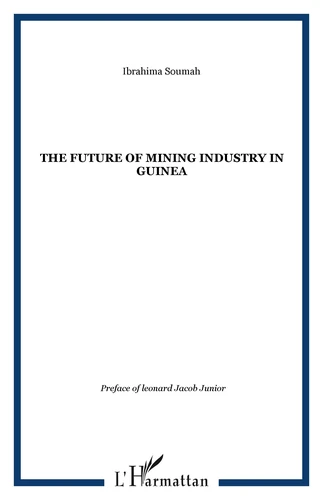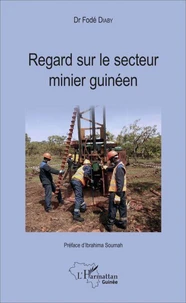The Future of Mining Industry in Guinea. Edition en anglais
Par :Formats :
Disponible dans votre compte client Decitre ou Furet du Nord dès validation de votre commande. Le format PDF est :
- Compatible avec une lecture sur My Vivlio (smartphone, tablette, ordinateur)
- Compatible avec une lecture sur liseuses Vivlio
- Pour les liseuses autres que Vivlio, vous devez utiliser le logiciel Adobe Digital Edition. Non compatible avec la lecture sur les liseuses Kindle, Remarkable et Sony
 , qui est-ce ?
, qui est-ce ?Notre partenaire de plateforme de lecture numérique où vous retrouverez l'ensemble de vos ebooks gratuitement
Pour en savoir plus sur nos ebooks, consultez notre aide en ligne ici
- Nombre de pages264
- FormatPDF
- ISBN978-2-296-21573-3
- EAN9782296215733
- Date de parution01/01/2009
- Copier Coller01 page(s) autorisée(s)
- Protection num.Digital Watermarking
- Taille9 Mo
- ÉditeurL'Harmattan
Résumé
Guinea was identified as a mining country long time ago rince quantity of gold coming from the Bouré region, near Siguiri, constituted the power and reputation of medieval Mandingue empire. Up to today, mines have ensured the greater part of export revenues as well as the budgetary receipts of the country. The mining potential has earned Guinea what is commonly called a geological scandai. We indeed know that the reserves of bauxite of more than 40 billions tons would be sufficient to supply world aluminum industry for about 500 years, which is three times longer than the time calculated for ail the petroleum oil known on earth.
But, for the Guinean people and those observing them, the real scandai is having so much resources and remaining among the poorest countries in the world with the HDI classification ranking Guinea to the 160 th place out of 175 countries, while its income per capita is below $500/year, compared to $ 20,000 in Western Europe and $ 30,000 in the USA and Japan. We also know that with good governance and a suitable institutional framework, Guinea could efficiently develop its resources and reach the standard of living of emerging countries like India and China.
The prerequisite is that rigorous training has to be established and good information is required regarding the situation of the mining sector in Guinea and around the world before laying down policier and strategies of development. This book provides information on the potential and the evolution of the Guinean mining sector as well as future prospects for the country by developing mining megaprojects.
But, for the Guinean people and those observing them, the real scandai is having so much resources and remaining among the poorest countries in the world with the HDI classification ranking Guinea to the 160 th place out of 175 countries, while its income per capita is below $500/year, compared to $ 20,000 in Western Europe and $ 30,000 in the USA and Japan. We also know that with good governance and a suitable institutional framework, Guinea could efficiently develop its resources and reach the standard of living of emerging countries like India and China.
The prerequisite is that rigorous training has to be established and good information is required regarding the situation of the mining sector in Guinea and around the world before laying down policier and strategies of development. This book provides information on the potential and the evolution of the Guinean mining sector as well as future prospects for the country by developing mining megaprojects.
Guinea was identified as a mining country long time ago rince quantity of gold coming from the Bouré region, near Siguiri, constituted the power and reputation of medieval Mandingue empire. Up to today, mines have ensured the greater part of export revenues as well as the budgetary receipts of the country. The mining potential has earned Guinea what is commonly called a geological scandai. We indeed know that the reserves of bauxite of more than 40 billions tons would be sufficient to supply world aluminum industry for about 500 years, which is three times longer than the time calculated for ail the petroleum oil known on earth.
But, for the Guinean people and those observing them, the real scandai is having so much resources and remaining among the poorest countries in the world with the HDI classification ranking Guinea to the 160 th place out of 175 countries, while its income per capita is below $500/year, compared to $ 20,000 in Western Europe and $ 30,000 in the USA and Japan. We also know that with good governance and a suitable institutional framework, Guinea could efficiently develop its resources and reach the standard of living of emerging countries like India and China.
The prerequisite is that rigorous training has to be established and good information is required regarding the situation of the mining sector in Guinea and around the world before laying down policier and strategies of development. This book provides information on the potential and the evolution of the Guinean mining sector as well as future prospects for the country by developing mining megaprojects.
But, for the Guinean people and those observing them, the real scandai is having so much resources and remaining among the poorest countries in the world with the HDI classification ranking Guinea to the 160 th place out of 175 countries, while its income per capita is below $500/year, compared to $ 20,000 in Western Europe and $ 30,000 in the USA and Japan. We also know that with good governance and a suitable institutional framework, Guinea could efficiently develop its resources and reach the standard of living of emerging countries like India and China.
The prerequisite is that rigorous training has to be established and good information is required regarding the situation of the mining sector in Guinea and around the world before laying down policier and strategies of development. This book provides information on the potential and the evolution of the Guinean mining sector as well as future prospects for the country by developing mining megaprojects.



















